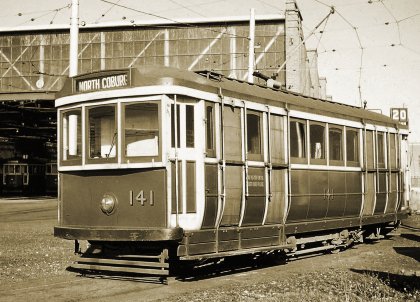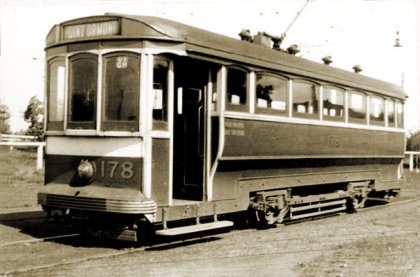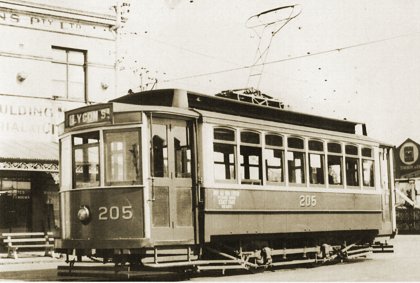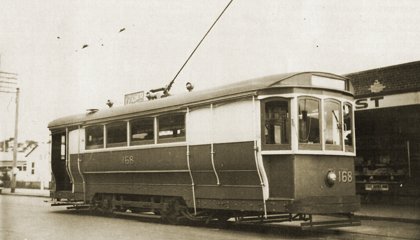Melbourne Tram Museum
- Follow Melbourne Tram Museum on Twitter
- Follow Melbourne Tram Museum on Facebook
- Follow Melbourne Tram Museum on Instagram
- Follow Melbourne Tram Museum on Pinterest
- Follow Melbourne Tram Museum on Tumblr
- Subscribe to Melbourne Tram Museum's RSS feed
- Email Melbourne Tram Museum
All night long: Melbourne’s recycled one-man cars
In 1935, as Melbourne was emerging from the hardship of the Great Depression, the M&MTB acquired a new Chairman, H.H. Bell. Conversion of remaining cable tram routes to electric traction recommenced, as well as construction of new routes. The improvement in passenger numbers driven by the recovering economy and the expansion of electric routes required the escalation of the W class tramcar construction program, through the placing of an order for 120 W5 class trams.
However, this left the M&MTB with a large stock of obsolescent single truck tramcars with at least ten more years of life in them. They were unsuitable for peak hour city traffic due to their limited capacity, and were substantially slower in these conditions as well. Bell was loathe to write off these tramcars at scrap value – both his personal business experience through the Depression of the 1890s and the recent Great Depression led him to a natural desire to maximise the return on investment wherever possible – so he was looking for a cost-effective way to maximise the revenue potential of these underutilised assets.
The improving economy had highlighted a need for public transport during the early hours of the morning, and the Birney type tramcars of the X, X1 and X2 classes pointed the way forward – the answer was to modify twenty-four obsolescent single truck tramcars of the Q [1] and R [2] classes to make them suitable for one-man operation of lightly loaded all-night services on selected routes, where speed and capacity would not be an issue. Furthermore, they could be used on daytime routes with small passenger loadings, such as the Point Ormond and Holden Street shuttle services.
 Q class 141 resting at Brunswick Depot before its next all-night roster,
17 January 1954.
Q class 141 resting at Brunswick Depot before its next all-night roster,
17 January 1954. - Photograph courtesy Noel Reed.
Bell was able to persuade the union of the merits of one-man crews on these services through the payment of higher wages to drivers on one-man rosters, also pointing out that these services were new and the extra responsibility of fare collection was not onerous, particularly as plenty of allowance was made in the timetable for recovery time. No doubt, the final stringencies of the recent Great Depression were also uppermost in the union’s mind, so the opportunity of additional shifts and higher wages for a number of its members was accepted.
The modifications to the tramcars were simple in nature, consisting of fixing the door weather blinds and barriers in the closed position for all doorways except for the leading doorway, together with cutting a doorway through the left side of the driver’s bulkhead and an aisle through the left side of the crossbench seats on the end platforms. The conversion was completed with exterior sign-writing next to the entrance advising passengers ‘Pay As You Enter’ and ‘Exact Fare Please’.
One tramcar underwent a much greater degree of modification to make it suitable for all-night service. T class [3] number 178 was totally rebuilt into an enclosed design, which involved extension of the saloons over the end platforms, replacement of the longitudinal wooden seating with transverse upholstered seats, closing off the rear doorways and fitting air-operated doors in the front entrance of the car. The objective was to produce a car comparable to the Birney design at minimal cost.
 T class 178 at Point Ormond terminus, circa 1947. Note the blackout
panels on the apron and the run number can be seen in the front window
showing allocation to Glenhuntly Depot.
T class 178 at Point Ormond terminus, circa 1947. Note the blackout
panels on the apron and the run number can be seen in the front window
showing allocation to Glenhuntly Depot.- Photographer unknown.
However, the rebuilding of T class number 178 was not entirely successful, as removal of internal bulkheads to open up the car interior reduced the structural strength of the car body, resulting in a less than desirable amount of body flexing [4]. The remaining five T class cars were not modified.
These modified one man tramcars of the Q, R and T classes were used on all-night services and lightly loaded routes interchangeably with the eighteen Birney type tramcars of the X, X1 and X2 classes, the five Peter Witt Y and Y1 class cars, as well as the four remaining tramcars of the thirty-year old U [5] class still in passenger service.
 Converted all-night car U class 205 on Holden Street shuttle service
circa 1938. Note experimental bow-collector mounted on roof.
Converted all-night car U class 205 on Holden Street shuttle service
circa 1938. Note experimental bow-collector mounted on roof.- Photograph Ray Pearson.
The action of Bell in introducing all-night services was prescient, as the onset of the Second World War in 1939 saw industry demand the provision of a greater level of public transport to support three-shift operation around the clock, particularly in the munitions factories located on the Footscray local routes. The existing one-man tramcar stock was insufficient to meet demand, so in 1941-42 fourteen S class [6] single truck tramcars were modified along the same lines as the Q and R class were five years previously.
However, rather than leaving the doorways closed off with canvas blinds, the blinds were replaced by masonite panels. This flexible and cheap hardboard was well suited to matching the complex curves of the S class tramcar body with minimal shaping, matching the austerity requirements of wartime industry.
Seven of the modified S class cars were transferred to the isolated Footscray routes for munitions service, stretching tramcar accommodation at the small Footscray Depot to the limit – the last car run in at night projected over the footpath – while the remaining seven cars remained on the main system primarily for all-night service.
 War-time austerity all-night tram S class 168 in Footscray in September
1947, at Ballarat Road terminus ready to depart for Williamstown Road
– note the use of masonite to close off drop ends of car.
War-time austerity all-night tram S class 168 in Footscray in September
1947, at Ballarat Road terminus ready to depart for Williamstown Road
– note the use of masonite to close off drop ends of car. - Photograph courtesy Bob Lilburn.
The all-night cars would see their greatest level of patronage during the Second World War, thanks to rationing and the demands of the wartime economy. Peacetime brought a growing level of militancy in the union, resulting in Footscray services reverting to two-man operation in 1947 after many years of successful one-man operation. Furthermore, the removal of fuel rationing and increasing level of private ownership of motor vehicles saw a declining requirement for all-night public transport. This led to a reduction of services, so all of the austerity S class one-man cars were withdrawn and scrapped between 1953 and 1955. The only surviving S class tramcar – number 164 – was never modified for one-man service.
The connection of the isolated Footscray lines to the main system in 1954 meant that the Birney type cars allocated to Footscray could undertake some of the all-night routes previously allocated to Essendon Depot, further reducing the need for all-night cars. This was one of the factors behind the withdrawal of most of the Q and R class cars between 1955 and 1957.
The final death knell for the all-night tramcar service was the introduction of television to Melbourne in 1956. Attendance at evening social events – cinemas, theatres and dances – crashed, removing what had been a major source of late night tram patronage. The following year saw the end of all-night services, as well as the Holden Street shuttle service operated by one-man trams. The last one-man service, the Elsternwick to Point Ormond shuttle, closed in 1960, ending the need for the converted cars.
Only one of the non-Birney trams that provided Melbourne with all-night services still survives in something like its all-night form – Q 199, which is undergoing restoration to its 1936-37 condition at the time of writing by the Tramway Museum Society of Victoria (TMSV), after it survived into preservation as service tramcar 16W. Three other all-night non-Birney cars also survive – Q 198 as sleeper transport car 15W and U 205 as NMETL 4 (under restoration), both in the TMSV collection, and Q 197 as scrubber 9W at Bendigo Tramways.
Bibliography
Cross, N., Henderson, R., and Kings, K. (1981) Destination City
(Fourth Edition), Australian Electric Traction Association
Cross, N., Budd, D., and Wilson, R. (1993) Destination City (Fifth
Edition), Transit Australia Publishing
Jones, R. (2005) Fares Please: An
economic history of the M&MTB, Melbourne Tram Museum
Jones, R. (2008) Hector Hercules Bell – ringing
in the new, Melbourne Tram Museum
Jones, R. (2010) Birney Safety Cars In Melbourne,
Melbourne Tram Museum
Footnotes
[1] The Q class was a single truck straight sill closed combination design of twenty-four cars built by the M&MTB at its Holden Street Workshops in 1922 and 1923. The cars were numbered in two blocks: 139-150 and 190-201. The twenty Q class cars converted for use as one-man cars were 139-150, 191-193 and 196-200.
[2] The R class was a single truck straight sill closed combination design of eight cars, very similar in appearance to the Q class, built for the Fitzroy, Northcote & Preston Tramways Trust by James Moore & Sons in 1920. In M&MTB service they were numbered 151-153 and 172-176. The four R class tramcars converted for use as one man cars were 151 and 174-176.
[3] The T class was a single truck drop-end open combination design of six cars built in 1917 by Duncan & Fraser for the Melbourne, Brunswick & Coburg Tramways Trust. The six T class tramcars were numbered 177-182 in M&MTB service.
[4] Inspection of the body of T 178 on a private property in the mid-1990s by the author confirmed the reduction in car body rigidity produced by the removal of internal bulkheads. This car was scrapped and the body sold in 1961.
[5] The U class was a single truck saloon design built by the J.G. Brill Company of Philadelphia for the North Melbourne Electric Tramways & Lighting Company. Numbered in the range 202-211 in M&MTB service, only four cars were still in passenger traffic in 1936-37 at the introduction of all-night services: numbers 205-206, 209 and 211. These cars would be progressively withdrawn from passenger service between 1938 and 1939, and either converted to service stock use or scrapped by 1945.
[6] The S class was a single truck drop end open California combination car design of eighteen cars, twelve of which were built for the Melbourne, Brunswick & Coburg Tramways Trust in 1916 (twelve cars numbered 154-165 in M&MTB service) and 1920-22 (six cars numbered 166-171 in M&MTB service).